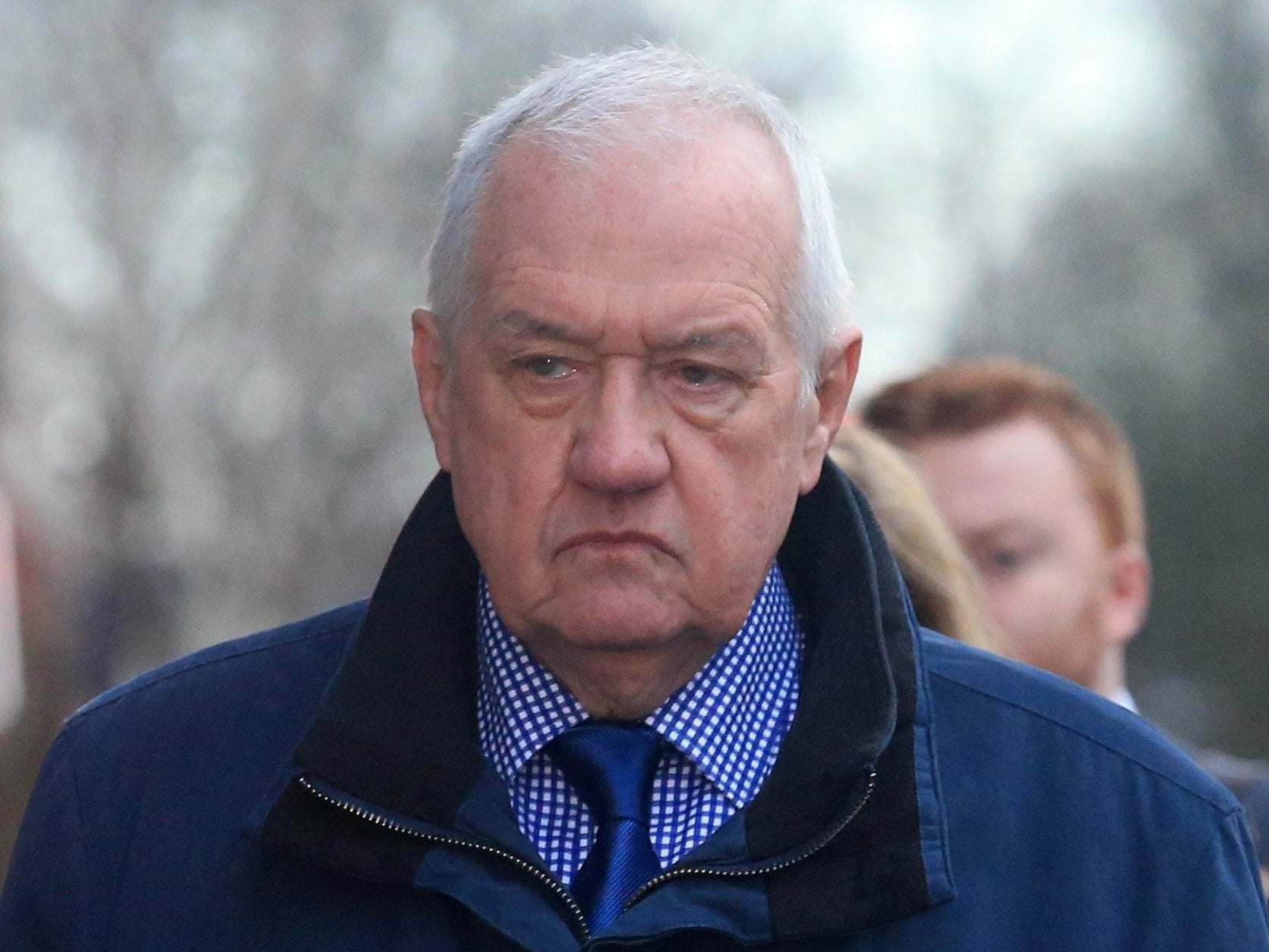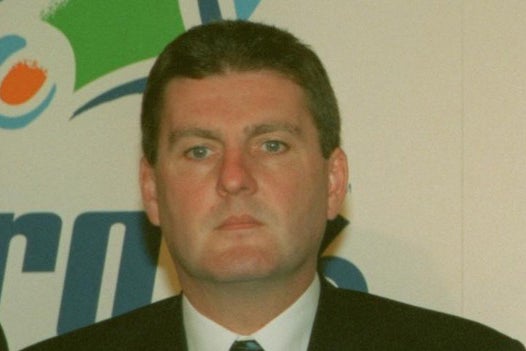Hillsborough trial: 'Extraordinarily bad failings' by match commander David Duckenfield caused fatal crush, court hears
David Duckenfield denies manslaughter of 95 victims
“Extraordinarily bad failings” by David Duckenfield led to the deaths of 95 Liverpool fans at Hillsborough stadium, a court has heard.
A prosecutor said the match commander, a former South Yorkshire Police chief superintendent, had “criminal responsibility” for the deaths of men, women and children who were crushed in the disaster.
Mr Duckenfield, now 74, sat metres away from victims’ relatives as all 95 names were read out at Preston Crown Court on Tuesday.
He denies manslaughter, while Sheffield Wednesday’s former safety officer Graham Mackrell pleads not guilty to two health and safety offences related to the stadium.
Richard Matthews QC, for the prosecution, told jurors that “many individual failures” played a part in the “appalling” events that unfolded on 15 April 1989.
“Undoubtedly, each of the deceased has been failed by many, in many ways and over a protracted period; before, during and even after this disaster,” he added.
“But is the prosecution’s case that Mr Duckenfield’s failures to discharge his personal responsibility were extraordinarily bad and contributed substantially to the deaths of each of those 96 people who so tragically and unnecessarily lost their lives.”
Ninety-four of the 96 victims died on the day of the disaster, while Lee Nicol passed away as a result of his injuries two days later.
There can be no prosecution over the death of the 96th victim, Tony Bland, as he died more than a year and a day after his injuries were caused.
Opening the prosecution’s case, Mr Matthews said that the match itself was not extraordinary, and mirrored the 1988 FA cup semi-final that was played between Liverpool and Nottingham Forest at Hillsborough.

He told the jury that in addition to failures in planning, organisation and management of the arrival, entry and accommodation of 50,000 football fans, there were also “many collective and individual failures to intervene effectively once the disaster unfolded”.
Mr Matthews said Mr Duckenfield did not declare the situation a “major incident” in good time, to put in place emergency measures to release those trapped and to provide adequate emergency medical attention and resuscitation.
“In the minutes before and after 3pm, 96 people received fatal injuries as a result of crushing in the central pens of the west terrace of the Leppings Lane end of the Hillsborough stadium,” he added, saying the youngest victim was just ten years old and many were teenagers.
“Each of those who died did so as a result of participation in the wholly innocent activity of attending a football match as a spectator, as a consequence of the obvious and serious risk to life posed by crushing from poor management of the expected capacity crowd … and as a result of the extraordinarily bad failures by David Duckenfield.”

The jury was shown images of the areas of Hillsborough stadium, which was the third-largest football ground in the UK at the time, where around 24,000 Liverpool fans attended the match.
Mr Matthews said that as thousands of spectators arrived, there were fears of injuries at turnstiles outside the stadium and a large exit gate known as Gate C was opened “following requests for Mr Duckenfield to do something to alleviate the crush”.
He told the jury that a large crowd was “naturally drawn” through a tunnel directly in front of the turnstiles, down a slope and into fenced pens where there were “no means to escape”.
Mr Duckenfield “gave no thought to the inevitable consequence of the flood of people through Gate C,” the prosecutor added. “He made no attempt to even monitor what was occurring, let alone take a step to avert the tragedy.”
Mr Mackrell, Sheffield Wednesday’s former safety officer, is accused of violating a government-issued safety guide and the terms of the stadium’s safety certificate regarding entry arrangements.
“It is the prosecution’s case that Mr Mackrell effectively shrugged off all responsibility for these important aspects of the role he had taken on as safety officer,” Mr Matthews added, detailing a lack of signage for alternative routes to standing terraces.
Mr Mackrell denies two health and safety offences.
Judge Openshaw said the Hillsborough disaster has received a “huge amount of publicity” for the past 30 years.
“What any of you have heard or read or seen in the past is entirely irrelevant to your task,” he told the jury.
“You decide what happened and whether these charges have been proved and you do so based on what you see and hear in the court, and nowhere else.”
The trial continues.
See our live coverage from the trial below
Please allow a moment for the live blog to load
A photo shows a large sign saying "standing" above the mouth of the tunnel, which was the description given on tickets. Routes to pens 1 and 2, and 6 and 7 were via two other tunnels some distance to the right and left.
The jury are still being taken through the layout of Hillsborough stadium.
Mr Matthews says anyone coming through turnstiles A to G were "confronted with the standing sign and tunnel". He says the arrangements had been in place for several years before Mr Mackrell took up his role as safety officers.
"Many of the Liverpool supporters who attended the 15th April 1989 would have visited Hillsborough before," he adds. "However in practice if you'd been before or if you were new to the Leppings Lane end of Hillsborough, a likely route once you were through turnstiles A to G was to go straight through the tunnel to pens 3 and 4."
Mr Matthews says the position of the tunnel and signage "suggested to anyone that it led to Leppings Lane standing marked on all tickets for that area".
Mr Matthews says that "if you were in pen 3 and it wasn't too crowded you could get to pen 2 through a gate at the rear of radial fencing, but not without some difficulty. And as you came out of the tunnel into pen 3 the gap in the fence was already behind you."
"There is a large sign above the turnstiles you see from the outside of A to G saying 'to the south stand', with an arrow," he adds. But if you were going to pen 1 or 2 of the West Stand, that is the direction you would have to go in.
"If you're holding Leppings Lane standing tickets, you are not naturally going to go on a route to a stand you have no allocation for."
Mr Matthews says there was another sign for standing tickets but it was "too small" to be read by anyone coming through the turnstiles, and there were no signs indicating that pens 6 and 7 and the north-west terrace was through an alternative route.
He says the tunnel had a maximum gradient of a maximum of 10 degrees, and that a sloping wall projected people out into the terrace and made it difficult to see what was to the left and right.
Mr Matthews says exit gate A and C were intended to clear crowds at the end of the match. The gates were a "concertina-like construction" made of metal with a hook.
"What flows from that is in the event of one of those gates were fully open to allow people to enter rather than exit, they would allow a lot more people into the stadium than could or would pass through turnstiles."
Mr Matthews says the turnstiles were not operating as on league matches, with operators taking cash for tickets, and that people were passing over pre-bought tickets and have a stub returned.
"It's obvious, if you think about it, that if you use a big exit gate as an entrance a lot of people are going to be able to come through at a far faster rate than would pass through the turnstiles," he adds.
Mr Matthews says dents in the fencing at gates at the rear of radial fences were not signposted as emergency exits.
"In the event of a crush, there is no means to escape other than in the direction the crowd pressure is coming from - up the slope of a terrace."
Mr Matthews said the corridor-like pen 5 was intended as a "sterile area free from fans" that could help separate supporters from opposing teams and allow police officers easy access to the West Terrace.
Evidence has now ended for the day and the court will re-convene at 10.30am tomorrow, when our live coverage will resume.

